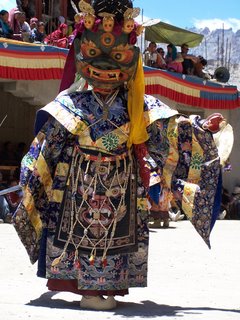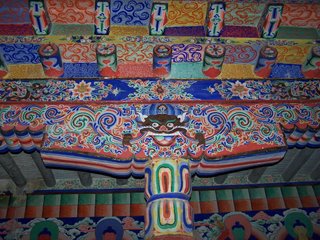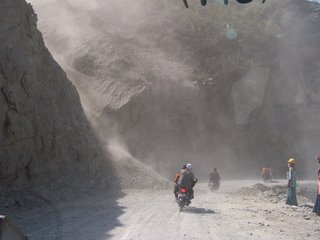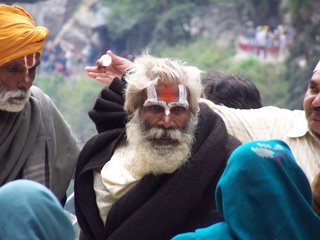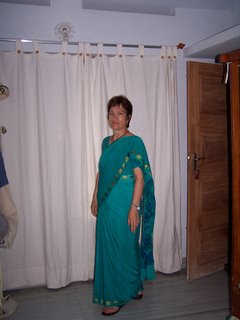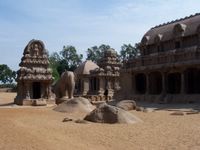Blogging about my travels since 2005. Also visit indiatrekker2 for other trips. It's a great world to see and learn.
Tuesday, September 05, 2006
Monday, September 04, 2006
 Sunrise over Himalayas, Tungnath. May 2006
Sunrise over Himalayas, Tungnath. May 2006 The best hike of the trip was out to Gaumukh (glacier which is the geological source of the Ganges River). Photo is of the glacier valley with huge Himalayan mountain in the distance and small settlement in foreground where we camped the night before. We did 23 kms this day which was our longest hike but not the toughest. That was reserved for Kedarnath - the hike from hell. May 2006.
The best hike of the trip was out to Gaumukh (glacier which is the geological source of the Ganges River). Photo is of the glacier valley with huge Himalayan mountain in the distance and small settlement in foreground where we camped the night before. We did 23 kms this day which was our longest hike but not the toughest. That was reserved for Kedarnath - the hike from hell. May 2006. Friday, August 25, 2006
Tamil Nadu by Motorcycle: Greetings! Sorry no photos this time as I'm not able to upload. So, at the beginning of August, I rode approximately 1,000 kms by motorcycle. From Cochin I traveled up into the Western Ghats to a hill station called Munnar. It exists primarily because of the tea grown in the area. Did some hiking. After a few days there it was south to Kumili near the The Periyar Wildlife Sanctuary which is an absolutely beautiful and breathtaking drive through mountains, cardamom groves, and tea estates. It's monsoon, so I bought rain gear and needed it as it was wet. Then headed east into Tamil Nadu. Moved out of the mountains very quickly into a vast plain that is hot and dry and desert like. Headed for Madurai.
Madurai or the "city of nectar" is the oldest and second largest city of Tamil Nadu (about 1.1million). It's an animated city packed with pilgrims, beggars, business people, bullock carts and legions of underemployed rickshaw- wallahs. Dating about 2500 years back in time, it is one of southern India's oldest cities. The Meenakshi Hindu temple, covers a vast area and is an eclectic mix of architectural styles. It is dedicated to Meenakshi, the consort of Lord Shiva and is one of the most important places of Hindu pilgrimages. The temple is splendid and I really enjoyed my time at the temple and walking around the city.
Changed plans in Madurai and instead of going east to Pondicherry on the Bay of Bengal headed south to Kanyakumari (referred as the 'Land's End' of India). Here, the Bay of Bengal confluences with the Indian Ocean and the Arabian Sea. You can watch the sun rise as well as the sunset and the moon rise. It, too, is an important revered pilgrim centre. The sea is fairly rough, so it is entertaining to watch it beat itself against the rocks and then subside, before it gathers itself up for another attack. The clouds in the sky, because it is monsoon time were dramatic. I had wanted to go here because I had been in Ladakh in the far north so being at the southern most tip, completed my trip. From here I rode up the west coast back into Kerala and stayed at Varkala Beach one night (it rained cats and dogs that night) and then returned to Cochin.
Madurai or the "city of nectar" is the oldest and second largest city of Tamil Nadu (about 1.1million). It's an animated city packed with pilgrims, beggars, business people, bullock carts and legions of underemployed rickshaw- wallahs. Dating about 2500 years back in time, it is one of southern India's oldest cities. The Meenakshi Hindu temple, covers a vast area and is an eclectic mix of architectural styles. It is dedicated to Meenakshi, the consort of Lord Shiva and is one of the most important places of Hindu pilgrimages. The temple is splendid and I really enjoyed my time at the temple and walking around the city.
Changed plans in Madurai and instead of going east to Pondicherry on the Bay of Bengal headed south to Kanyakumari (referred as the 'Land's End' of India). Here, the Bay of Bengal confluences with the Indian Ocean and the Arabian Sea. You can watch the sun rise as well as the sunset and the moon rise. It, too, is an important revered pilgrim centre. The sea is fairly rough, so it is entertaining to watch it beat itself against the rocks and then subside, before it gathers itself up for another attack. The clouds in the sky, because it is monsoon time were dramatic. I had wanted to go here because I had been in Ladakh in the far north so being at the southern most tip, completed my trip. From here I rode up the west coast back into Kerala and stayed at Varkala Beach one night (it rained cats and dogs that night) and then returned to Cochin.
Sunday, July 30, 2006
Vijnana Kala Vedi Centre, Aranmula, Kerela: I arrived July 1 in the most south-western state of India, Kerala, after a 50 hour train ride from Delhi (whew... good experience but dont' think I will do that again). Last year I spent a bit of time in Kerala and liked it very much so my plan is to spend more time here this summer. During July I attended a school for the Keralan/Indian arts in a small village called Aranmula. It is about equidistance between the two major cities of Kerala: Trivandum and Cochin. This area which is about an hour from the coast is lush and tropical with banana and palm trees, rice paddies and of course the monsoon is here!
Vijnana Kala Vedi Cultural Centre was started by a French woman about 23 years ago to preserve and promote the traditional arts of Kerala like its music, dance, drama, language, painting, cooking, etc. They also offer languages, introduction to Ayurveda, yoga. I came for the Ayurveda course which was taught to just two students by Dr. Hari Kumar (www.doctorhari.com). He is just excellent and I learned a lot. I also took a traditional Kerala cooking class and Hindi. These classes were taught one to one. Yoga is available most days as drop in class - afterall this is India! The village of Aranmula is lively and the locals find us curious. There are about 20 students at the centre and we reside in one of three houses situated in the village. My house usually has one or two cows out front that cut the grass. There are working elephants in the district and you see them occassionally on the road going here and there with their master (the mahoot). There is a very famous Hindu temple in the village which draws many pilgrims and the chants of the priests seem to go 24 hours - over loud speakers. So this is always in the back ground. There is a sacred river - The Pampa - which is now swollen with monsoon rain. The locals swim in it, but I stayed away from such activity. A couple of weekends ago a few of us headed to the coast to a beach town - Kovalam. Swam in a pool there as the sea is too dangerous. The beach had black sand and because it is low season (monsoon) the room rates at the hotel were about 200 rupees which is about CDN $5.00.
Below are some photos. One is me with a Delhi family. I went to their house for dinner. The others are, Kerala mural painter, sample of traditional Kerala painting, metal worker making mirror, my house in Aranmula, the local corner store, the bicycle repair man, the umbrella repair man ( a very necessary person during monsoon), and elephant going to work.
Well I am out of here as of August 1 and headed to the big city of Cochin. Not sure what August will hold for me. I think I'll travel more throughout Kerala and the state of Tamil Nadu. Stay tuned.
Vijnana Kala Vedi Cultural Centre was started by a French woman about 23 years ago to preserve and promote the traditional arts of Kerala like its music, dance, drama, language, painting, cooking, etc. They also offer languages, introduction to Ayurveda, yoga. I came for the Ayurveda course which was taught to just two students by Dr. Hari Kumar (www.doctorhari.com). He is just excellent and I learned a lot. I also took a traditional Kerala cooking class and Hindi. These classes were taught one to one. Yoga is available most days as drop in class - afterall this is India! The village of Aranmula is lively and the locals find us curious. There are about 20 students at the centre and we reside in one of three houses situated in the village. My house usually has one or two cows out front that cut the grass. There are working elephants in the district and you see them occassionally on the road going here and there with their master (the mahoot). There is a very famous Hindu temple in the village which draws many pilgrims and the chants of the priests seem to go 24 hours - over loud speakers. So this is always in the back ground. There is a sacred river - The Pampa - which is now swollen with monsoon rain. The locals swim in it, but I stayed away from such activity. A couple of weekends ago a few of us headed to the coast to a beach town - Kovalam. Swam in a pool there as the sea is too dangerous. The beach had black sand and because it is low season (monsoon) the room rates at the hotel were about 200 rupees which is about CDN $5.00.
Below are some photos. One is me with a Delhi family. I went to their house for dinner. The others are, Kerala mural painter, sample of traditional Kerala painting, metal worker making mirror, my house in Aranmula, the local corner store, the bicycle repair man, the umbrella repair man ( a very necessary person during monsoon), and elephant going to work.
Well I am out of here as of August 1 and headed to the big city of Cochin. Not sure what August will hold for me. I think I'll travel more throughout Kerala and the state of Tamil Nadu. Stay tuned.
Sunday, July 09, 2006
Ladakhi woman in tradional dress with prayer wheel and view of Himalaya mountains and fertile valley in Ladakh. 

Ladakh. First some background. The state of Jammu & Kashmir in northern India consists of the regions of Kashmir, Jammu and Ladakh. Ladakh is predominantly Buddhist with a small Muslim population. Travel advisories issued by foreign gov'ts have lumped Ladakh into the same danger category as Kashmir without making any exception for the city of Leh and the Indus Valley. This is underserved. The Indus Valley is as safe as other parts of India. Ladakh - the land of high passes - separates the peaks of the western Himalaya from the vast Tibetan plateau.It is often called "Lttle Tibet" because of it's similarities in topography and culture with nearby Tibet. The Himalayas are high (6 - 7,000 metres) and snow capped. The valleys are desert like. The Ladakhis are expert farmers / gardeners and use the water resources from the major rivers and mountain streams to their significant advantage. Dotted throught the vast and awesome landscape are villages that are green, green, green. They are like an oasis in a sea of brown, red, orange, purple and green rock. (see photo included) The temperature this time of year can be extreme - 30 degrees in the day to -3 degrees at night. The sun is brilliant due to high altitude and less pollution and the stars shine so bright and are so plentiful you have trouble picking out the constellations.
Trekking / hiking is one of the major activity here, plus visiting Buddhist gompas (monastries) which dominate the landscape.
Leaving the excruciating heat of Delhi, June 15, I took the one hour flight to Leh and spent two weeks travelling around the Indus and Nubra valleys by jeep and doing some hiking and visiting gompas. Flying to Leh is challenging on two fronts - the security is extreme and at an altitude of 3,500 metres you invariably suffer some symptions of altitude sickness. Luckily I was not viewed as a risk and had little AMS to contend with probably due to all the high altitude hiking I did previously in Uttaranchal.
Some of the highlights for me was hiking up to the Kardung La Pass. We had started out by jeep but because it had snowed the night before, many vehicles were stuck. Rather than wait around I walked up the road the final 5 km to the "highest motorable pass in the world" at 5,602 metres (about 18,000 feet). Quite spectacular. We were headed into the Nubra Valley. On the way back to Leh, three days later, there was a snow avalanche and once again I walked up to the pass, while they dug out with one broken shovel and a pie plate. Don't ask me why eveyone doesn't carry a shovel in this region but they don't. Later in the week we happened upon a festival at a monastry in Lamayuru (the oldest known gompa in Ladakh) which was colourful and riveting. One of the best things about it was all the locals were there wearing their traditional dress which was fantastic (see other photo). The village of Alchi and it's gompa was so picturesque and restul we stayed an extra night to enjoy it. I stayed at the Zimskhang Guest House and shared a room (with a British woman who I was travelling with) for 500 rupees / night which is roughly $12 - $13 between the two of us. My base of operation in Leh was the family run guest house call the Oriental (350 rupees / night about $8) and both I would highly recommend if you ever come to Ladakh.
One last gompa - Thiksey - 17 km south of Leh is well worth the visit in early morning (6:00 a.m.) to hear the monks observe puja (morning prayers). Lots of chanting, banging on drums and blowing of horns.
So, on June 28 I flew out of Leh and returned to the heat of Delhi. Monsoon is late and the heat is oppressive. I had unfortunately been violently ill the night before my flight so arrived in the city in a weakened state and it took some time to recover. Guess it was something I ate !?!. Next stop .... Kerala in South India.


Ladakh. First some background. The state of Jammu & Kashmir in northern India consists of the regions of Kashmir, Jammu and Ladakh. Ladakh is predominantly Buddhist with a small Muslim population. Travel advisories issued by foreign gov'ts have lumped Ladakh into the same danger category as Kashmir without making any exception for the city of Leh and the Indus Valley. This is underserved. The Indus Valley is as safe as other parts of India. Ladakh - the land of high passes - separates the peaks of the western Himalaya from the vast Tibetan plateau.It is often called "Lttle Tibet" because of it's similarities in topography and culture with nearby Tibet. The Himalayas are high (6 - 7,000 metres) and snow capped. The valleys are desert like. The Ladakhis are expert farmers / gardeners and use the water resources from the major rivers and mountain streams to their significant advantage. Dotted throught the vast and awesome landscape are villages that are green, green, green. They are like an oasis in a sea of brown, red, orange, purple and green rock. (see photo included) The temperature this time of year can be extreme - 30 degrees in the day to -3 degrees at night. The sun is brilliant due to high altitude and less pollution and the stars shine so bright and are so plentiful you have trouble picking out the constellations.
Trekking / hiking is one of the major activity here, plus visiting Buddhist gompas (monastries) which dominate the landscape.
Leaving the excruciating heat of Delhi, June 15, I took the one hour flight to Leh and spent two weeks travelling around the Indus and Nubra valleys by jeep and doing some hiking and visiting gompas. Flying to Leh is challenging on two fronts - the security is extreme and at an altitude of 3,500 metres you invariably suffer some symptions of altitude sickness. Luckily I was not viewed as a risk and had little AMS to contend with probably due to all the high altitude hiking I did previously in Uttaranchal.
Some of the highlights for me was hiking up to the Kardung La Pass. We had started out by jeep but because it had snowed the night before, many vehicles were stuck. Rather than wait around I walked up the road the final 5 km to the "highest motorable pass in the world" at 5,602 metres (about 18,000 feet). Quite spectacular. We were headed into the Nubra Valley. On the way back to Leh, three days later, there was a snow avalanche and once again I walked up to the pass, while they dug out with one broken shovel and a pie plate. Don't ask me why eveyone doesn't carry a shovel in this region but they don't. Later in the week we happened upon a festival at a monastry in Lamayuru (the oldest known gompa in Ladakh) which was colourful and riveting. One of the best things about it was all the locals were there wearing their traditional dress which was fantastic (see other photo). The village of Alchi and it's gompa was so picturesque and restul we stayed an extra night to enjoy it. I stayed at the Zimskhang Guest House and shared a room (with a British woman who I was travelling with) for 500 rupees / night which is roughly $12 - $13 between the two of us. My base of operation in Leh was the family run guest house call the Oriental (350 rupees / night about $8) and both I would highly recommend if you ever come to Ladakh.
One last gompa - Thiksey - 17 km south of Leh is well worth the visit in early morning (6:00 a.m.) to hear the monks observe puja (morning prayers). Lots of chanting, banging on drums and blowing of horns.
So, on June 28 I flew out of Leh and returned to the heat of Delhi. Monsoon is late and the heat is oppressive. I had unfortunately been violently ill the night before my flight so arrived in the city in a weakened state and it took some time to recover. Guess it was something I ate !?!. Next stop .... Kerala in South India.
Sunday, June 25, 2006
Char Dham. My trip starts in Uttaranchal which is a state north of Delhi. I left Toronto May 17 to arrive in Delhi May 18 but as luck would have it, it took 30 extra hours to reach Delhi via Chicago, New York and London. (Thanks Amercian Airlines!!) I met up with my cousin A. in Delhi who was leading this part of the trip as she wanted to finish some of her Ph.D. research.
But, first we screamed down the highway to Jaipur to visit some friends and shop! Jaipur is a great town for textiles and A. is getting married in 2007 so she picked up a magnificent wedding sari of Benares silk and some other trinkets. We hired a driver to take us back to Delhi and it turned out both the driver and the car were not in best of shape. He continually fell asleep at the wheel and we had to keep yelling at him to wake up and then the car stopped running. He managed to get a mechanic at the side of the road to sort of fix it but it died again on a multi-lane highway south of Delhi. A. and I got out to push the damn thing in order to jump start it, much to the amusement of passing Indian motorists. It was all rather surreal - two white women in 45 degree heat, pushing a small car in 8 lanes of fast moving traffic. Our mothers would be proud!
So, on to Uttranchal. From Delhi we took at train north to Dehra Dun (capital of the state) and at that point decided to hire a driver for our two week excursion in the mountains rather than take public transportation. Our destination was the Char Dham (Four Sacred Abodes). These are Yamunotri, Gangotri, Kedarnath and Badrinath. They are pilgrimage sites for Hindus and exist at the spiritual source of the four sacred rivers in India. It involves many long hours in a jeep, over mountain roads that are treacherous, followed by hiking up mountains to each shrine site, finding accomodation which can sometimes be quite "crusty" and seeing some of the most magnificent scenery in the world as this entire trip is situated in the Himalayas.
Our hikes were anywhere from 6kms to 23 kms in a day. Our jeep rides were anywhere from 6 to what felt like 12 hours per day. The hiking altitude was from, 2400 to 3600 metres, the peaks we saw were up to 6000 to 7000 metres high, the pilgrims were plentiful - in the thousands, the weather was good and bad - sun, rain, mud, cold, heat, the shrines and temples were powerful, the landslides were scary as were many of the moutain roads which were more like trails. It was the most amazing trip of my life.
We made a side trip to a place call Tungnath which is a small grouping of huts on top of a mountain. It was a 3 km hike up, sleep in a bunker and then get up at 4 am to hike the last 1 km to the top and watch the sun rise over the Himalayas. It was a 360 degree view of the most stunning mountains, the highest being Nanda Devi which at 7,820 metres is the second highest peak in India. We then returned down to the jeep and on our way down in the vehicle we saw a wild leopard by the side of the road. Truly one of my most memorable days.
Back in Delhi by June 9 the heat is unbelieveable. Over 40 degrees celcius and there is a wind blowing they call the "Loo" which is hot and dry and it is said it brings disease and death. A. and I stayed in a small guest house but we went to a very large hotel and jump in their pool after being pampered at the spa. A. left for home June 12 and I got sick with heat exhaustion which last about 36 hours and was not fun.
So ends part one of my journey. On June 15 I flew to Leh in Ladakh and I will update you all on my travels there in the next update.
But, first we screamed down the highway to Jaipur to visit some friends and shop! Jaipur is a great town for textiles and A. is getting married in 2007 so she picked up a magnificent wedding sari of Benares silk and some other trinkets. We hired a driver to take us back to Delhi and it turned out both the driver and the car were not in best of shape. He continually fell asleep at the wheel and we had to keep yelling at him to wake up and then the car stopped running. He managed to get a mechanic at the side of the road to sort of fix it but it died again on a multi-lane highway south of Delhi. A. and I got out to push the damn thing in order to jump start it, much to the amusement of passing Indian motorists. It was all rather surreal - two white women in 45 degree heat, pushing a small car in 8 lanes of fast moving traffic. Our mothers would be proud!
So, on to Uttranchal. From Delhi we took at train north to Dehra Dun (capital of the state) and at that point decided to hire a driver for our two week excursion in the mountains rather than take public transportation. Our destination was the Char Dham (Four Sacred Abodes). These are Yamunotri, Gangotri, Kedarnath and Badrinath. They are pilgrimage sites for Hindus and exist at the spiritual source of the four sacred rivers in India. It involves many long hours in a jeep, over mountain roads that are treacherous, followed by hiking up mountains to each shrine site, finding accomodation which can sometimes be quite "crusty" and seeing some of the most magnificent scenery in the world as this entire trip is situated in the Himalayas.
Our hikes were anywhere from 6kms to 23 kms in a day. Our jeep rides were anywhere from 6 to what felt like 12 hours per day. The hiking altitude was from, 2400 to 3600 metres, the peaks we saw were up to 6000 to 7000 metres high, the pilgrims were plentiful - in the thousands, the weather was good and bad - sun, rain, mud, cold, heat, the shrines and temples were powerful, the landslides were scary as were many of the moutain roads which were more like trails. It was the most amazing trip of my life.
We made a side trip to a place call Tungnath which is a small grouping of huts on top of a mountain. It was a 3 km hike up, sleep in a bunker and then get up at 4 am to hike the last 1 km to the top and watch the sun rise over the Himalayas. It was a 360 degree view of the most stunning mountains, the highest being Nanda Devi which at 7,820 metres is the second highest peak in India. We then returned down to the jeep and on our way down in the vehicle we saw a wild leopard by the side of the road. Truly one of my most memorable days.
Back in Delhi by June 9 the heat is unbelieveable. Over 40 degrees celcius and there is a wind blowing they call the "Loo" which is hot and dry and it is said it brings disease and death. A. and I stayed in a small guest house but we went to a very large hotel and jump in their pool after being pampered at the spa. A. left for home June 12 and I got sick with heat exhaustion which last about 36 hours and was not fun.
So ends part one of my journey. On June 15 I flew to Leh in Ladakh and I will update you all on my travels there in the next update.
Wednesday, May 17, 2006
Monday, February 20, 2006
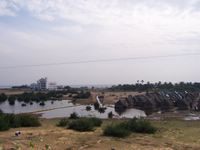
On our way south from Chennai to Mahabalipuram we passed areas that the December 2004 Tsunami swept over. the huts on the right are temporary, built after the disaster. The white building stayed intact. The water you see is actually from recent rain. In the distance is the Bay of Bengal. People are suppose to have permanent housing by now but it hasn't happened. 8,000 Indians died in the Tsunami.


Big ol' crocodile in a swamp in Sri Lanka. He was huge. Had to be 15 feet long and it looked like he had eaten a cow his middle area was so distended. The guide brought the small boat we were in too close to this guy for my liking. Just after I snapped this photo he flipped into the water and swam under the boat. I was very nervous at that point. One whip of his enormous tail and we all would have been breakfast, lunch and dinner!


Elephants in Pinnawala Elephant Orphanage, Sri Lanka. Most elephants here (and there had to be about 200) are young animals that have been found throughout the country, sick and abandoned by their herd. They are brought to Pinnewala. These two young ones are tethered by chains as they are still quite wild. Once they get use to the place they can roam free.


A very big stupa in Sri Lanka. Stupas, which characterise Buddist places of worship, essentially evolved from burial mounds. They were never designed to hold congregations, but were to serve as repositories for relics of the Buddha and later other venerated souls. You cannot go inside them. The faithful walk around them and give offerings in little shrines. Stupas are scattered around India and Sri Lanka.


Sigiriya, Sri Lanka. The complex lies on the steep slopes and at the summit of a granite peak standing some 370m (1,200 feet) high. This is the earliest surviving royal palace in Sri Lanka. This archaeological site, unparalleled in South Asia, has been declared a World Heritage site - and I'm going to climb it!

Subscribe to:
Posts (Atom)



